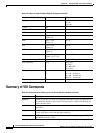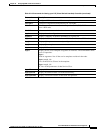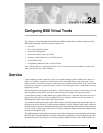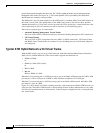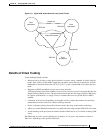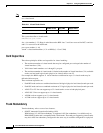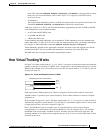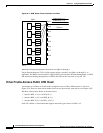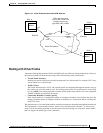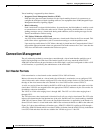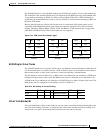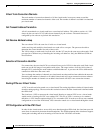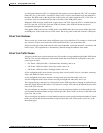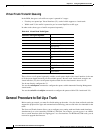
24-5
Cisco BPX 8600 Series Installation and Configuration
Release 9.3.10, Part Number 78-11603-01 Rev. D0, July 2001
Chapter 24 Configuring BXM Virtual Trunks
How Virtual Trunking Works
trunk. The commands addapsln, delapsln, switchapsln,andcnfapsln are all supported on virtual
trunk ports. For more information, refer to the Chapter 25, Configuring SONET Automatic
Protection System.
• Y-redundancy
The original trunk redundancy feature is an IGX-only feature and is not used for virtual trunks. The
commands addtrkred, deltrkred,anddsptrkred are rejected for virtual trunks.
ATM trunk redundancy is the T3 and E3 trunk redundancy supported by the AIT, ALM/B, and BTM
cards. Redundancy can exist between either:
• an AIT card and BNI (BPX) card
• an ALM/B and BNI card
• aBTMandaBNIcard
Virtual trunking and trunk redundancy are incompatible. Trunk redundancy uses the standard trunk
cables rather than a Y-cable. (For all service card sets other than trunk cards, you manage redundancy
by using the Y-cable redundancy commands addyred, delyred, prtyred,anddspyred).
Trunk redundancy depends on the applicable commands, the trunk card in the adjacent slot, and the
standard trunk cable. You can execute trunk redundancy commands only on the IGX node.
The BPX node does not require information regarding this feature.
How Virtual Trunking Works
In Figure 24-2, three virtual trunks 4.1.1, 4.1.2, and 4.1.3 are shown configured on a physical trunk that
connects to the port 4.1 interface of a BXM. Also, a single trunk is shown configured on port 4.2 of the
BXM. In this example, four VIs have been used, one each for virtual trunks 4.1, 4.2, and 4.3, and one
for physical trunk 4.2.
Figure 24-2 Virtual and Physical Trunks on a BXM
Each logical trunk, whether physical or virtual is assigned a virtual interface when it is activated.
A BXM card has 31 possible egress virtual interfaces. Each of these interfaces in turn has 16 Qbins
assigned to it.
In the example in Figure 24-3, port 1 has three virtual trunks (4.1.1, 4.1.2, and 4.1.3), each of which is
automatically assigned a virtual interface (VI) with the VI’s associated 16 Qbins. Port 2 is shown with
a single physical trunk (4.2) and is assigned a single VI.
On a 1-port BXM-622 card, for example, up to 31 virtual interfaces can be used on the port
corresponding to 31 virtual trunks. On an 8-port BXM 155 card, for example, the 31 VIs would be
distributed to the active trunks, standard or virtual. If trunks were activated on all eight ports, the
maximum number of VIs which can be assigned to one port is 24 (31 less 1 for each of the other 7 trunks
activated on the card).
17720
Multiple logical trunks (virtual trunks)
Single logical trunk (physical trunk)
4.1.1
4.1.2
4.1.3
4.2




